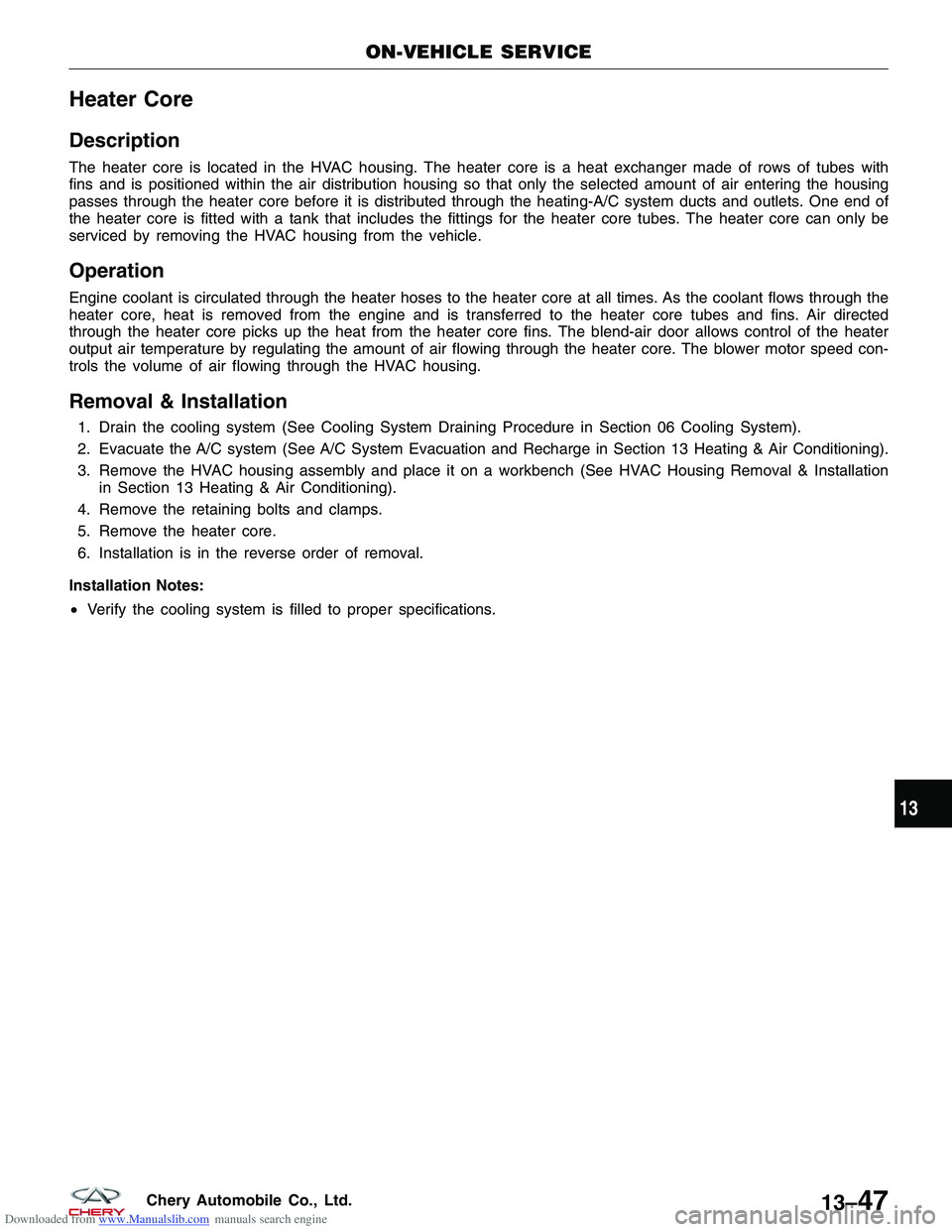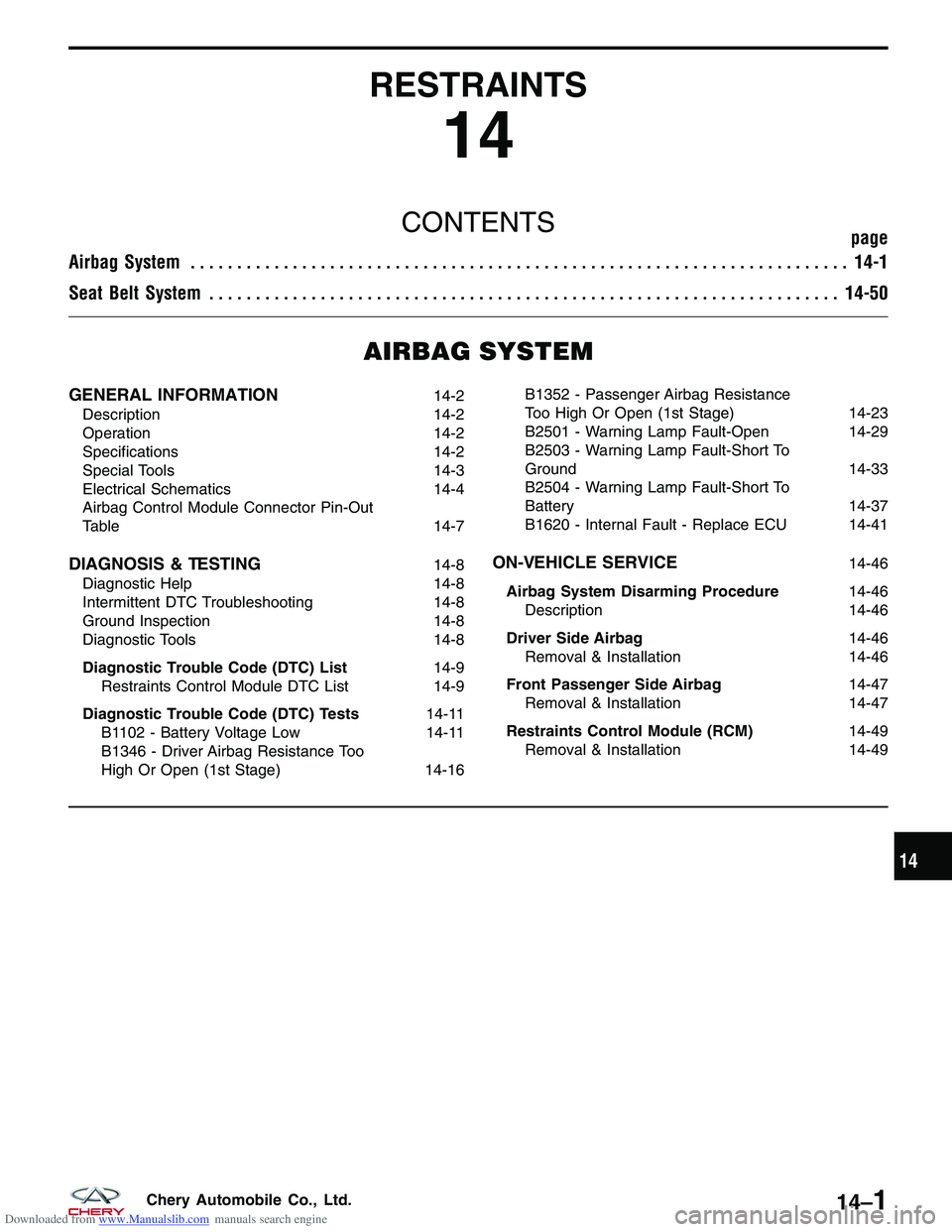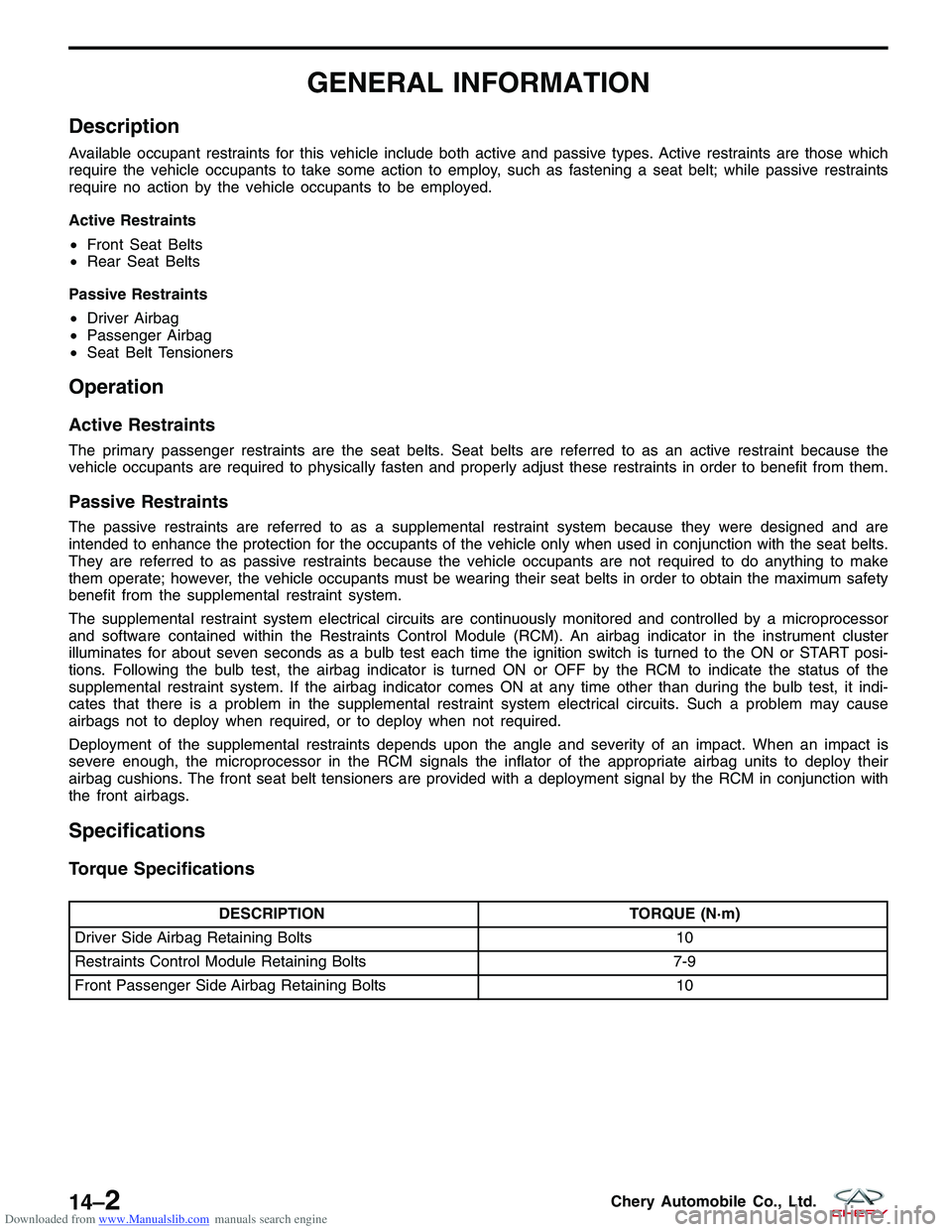Page 1529 of 1903

Downloaded from www.Manualslib.com manuals search engine Heater Core
Description
The heater core is located in the HVAC housing. The heater core is a heat exchanger made of rows of tubes with
fins and is positioned within the air distribution housing so that only the selected amount of air entering the housing
passes through the heater core before it is distributed through the heating-A/C system ducts and outlets. One end of
the heater core is fitted with a tank that includes the fittings for the heater core tubes. The heater core can only be
serviced by removing the HVAC housing from the vehicle.
Operation
Engine coolant is circulated through the heater hoses to the heater core at all times. As the coolant flows through the
heater core, heat is removed from the engine and is transferred to the heater core tubes and fins. Air directed
through the heater core picks up the heat from the heater core fins. The blend-air door allows control of the heater
output air temperature by regulating the amount of air flowing through the heater core. The blower motor speed con-
trols the volume of air flowing through the HVAC housing.
Removal & Installation
1. Drain the cooling system (See Cooling System Draining Procedure in Section 06 Cooling System).
2. Evacuate the A/C system (See A/C System Evacuation and Recharge in Section 13 Heating & Air Conditioning).
3. Remove the HVAC housing assembly and place it on a workbench (See HVAC Housing Removal & Installationin Section 13 Heating & Air Conditioning).
4. Remove the retaining bolts and clamps.
5. Remove the heater core.
6. Installation is in the reverse order of removal.
Installation Notes:
• Verify the cooling system is filled to proper specifications.
ON-VEHICLE SERVICE
13
13–47Chery Automobile Co., Ltd.
Page 1530 of 1903

Downloaded from www.Manualslib.com manuals search engine RESTRAINTS
14
CONTENTSpage
Airbag System ....................................................................... 14-1
Seat Belt System .................................................................... 14-50
AIRBAG SYSTEM
GENERAL INFORMATION14-2
Description 14-2
Operation 14-2
Specifications 14-2
Special Tools 14-3
Electrical Schematics 14-4
Airbag Control Module Connector Pin-Out
Table 14-7
DIAGNOSIS & TESTING14-8
Diagnostic Help 14-8
Intermittent DTC Troubleshooting 14-8
Ground Inspection 14-8
Diagnostic Tools 14-8
Diagnostic Trouble Code (DTC) List 14-9
Restraints Control Module DTC List 14-9
Diagnostic Trouble Code (DTC) Tests 14-11
B1102 - Battery Voltage Low 14-11
B1346 - Driver Airbag Resistance Too
High Or Open (1st Stage) 14-16B1352 - Passenger Airbag Resistance
Too High Or Open (1st Stage)
14-23
B2501 - Warning Lamp Fault-Open 14-29
B2503 - Warning Lamp Fault-Short To
Ground 14-33
B2504 - Warning Lamp Fault-Short To
Battery 14-37
B1620 - Internal Fault - Replace ECU 14-41ON-VEHICLE SERVICE14-46
Airbag System Disarming Procedure 14-46
Description 14-46
Driver Side Airbag 14-46
Removal & Installation 14-46
Front Passenger Side Airbag 14-47
Removal & Installation 14-47
Restraints Control Module (RCM) 14-49
Removal & Installation 14-49
14
14–1Chery Automobile Co., Ltd.
Page 1531 of 1903

Downloaded from www.Manualslib.com manuals search engine GENERAL INFORMATION
Description
Available occupant restraints for this vehicle include both active and passive types. Active restraints are those which
require the vehicle occupants to take some action to employ, such as fastening a seat belt; while passive restraints
require no action by the vehicle occupants to be employed.
Active Restraints
•Front Seat Belts
• Rear Seat Belts
Passive Restraints
• Driver Airbag
• Passenger Airbag
• Seat Belt Tensioners
Operation
Active Restraints
The primary passenger restraints are the seat belts. Seat belts are referred to as an active restraint because the
vehicle occupants are required to physically fasten and properly adjust these restraints in order to benefit from them.
Passive Restraints
The passive restraints are referred to as a supplemental restraint system because they were designed and are
intended to enhance the protection for the occupants of the vehicle only when used in conjunction with the seat belts.
They are referred to as passive restraints because the vehicle occupants are not required to do anything to make
them operate; however, the vehicle occupants must be wearing their seat belts in order to obtain the maximum safety
benefit from the supplemental restraint system.
The supplemental restraint system electrical circuits are continuously monitored and controlled by a microprocessor
and software contained within the Restraints Control Module (RCM). An airbag indicator in the instrument cluster
illuminates for about seven seconds as a bulb test each time the ignition switch is turned to the ON or START posi-
tions. Following the bulb test, the airbag indicator is turned ON or OFF by the RCM to indicate the status of the
supplemental restraint system. If the airbag indicator comes ON at any time other than during the bulb test, it indi-
cates that there is a problem in the supplemental restraint system electrical circuits. Such a problem may cause
airbags not to deploy when required, or to deploy when not required.
Deployment of the supplemental restraints depends upon the angle and severity of an impact. When an impact is
severe enough, the microprocessor in the RCM signals the inflator of the appropriate airbag units to deploy their
airbag cushions. The front seat belt tensioners are provided with a deployment signal by the RCM in conjunction with
the front airbags.
Specifications
Torque Specifications
DESCRIPTION TORQUE (N·m)
Driver Side Airbag Retaining Bolts 10
Restraints Control Module Retaining Bolts 7-9
Front Passenger Side Airbag Retaining Bolts 10
14–2Chery Automobile Co., Ltd.
Page 1532 of 1903
Downloaded from www.Manualslib.com manuals search engine Special Tools
Diagnostic Scan ToolX-431
Digital MultimeterFluke 15B & 17B
General Airbag Special Load Tool - Resistor Harness (For Driver’s and Passenger’s (Front) Airbag)
General Airbag Special Load Tool - Dummy Resistor
GENERAL INFORMATION
14
14–3Chery Automobile Co., Ltd.
Page 1533 of 1903
Downloaded from www.Manualslib.com manuals search engine Electrical Schematics
Airbag Control System (Page 1 of 3)
GENERAL INFORMATION
LTSMW140011T
14–4Chery Automobile Co., Ltd.
Page 1534 of 1903
Downloaded from www.Manualslib.com manuals search engine Airbag Control System (Page 2 of 3)
GENERAL INFORMATION
LTSMW140009T
14
14–5Chery Automobile Co., Ltd.
Page 1535 of 1903
Downloaded from www.Manualslib.com manuals search engine Airbag Control System (Page 3 of 3)
GENERAL INFORMATION
LTSMW140010T
14–6Chery Automobile Co., Ltd.
Page 1536 of 1903
Downloaded from www.Manualslib.com manuals search engine Airbag Control Module Connector Pin-Out Table
PINCIRCUIT IDENTIFICATION PINCIRCUIT IDENTIFICATION
1 Driver Seatbelt Pre-tensioner Lo 14Front Passenger Airbag Lo
2 Driver Seatbelt Pre-tensioner Hi 15-
3 Front Passenger Seatbelt Pre-tensioner Hi 16 -
4 Front Passenger Seatbelt Pre-tensioner Lo 17 -
5 Ignition Switch 18-
6 GND 19-
7 Airbag Lamp 20-
8 -21 -
9 Diagnostic Link K 22-
10 Driver Airbag Lo 23-
11 Driver Airbag Hi 24-
12 -25 -
13 Front Passenger Airbag Hi
GENERAL INFORMATION
14
14–7Chery Automobile Co., Ltd.